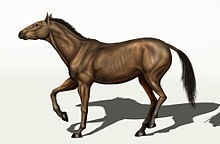Equus conversidens
| Equus conversidens Temporal range:
| |
|---|---|

| |
| Scientific classification | |
| Domain: | Eukaryota |
| Kingdom: | Animalia |
| Phylum: | Chordata |
| Class: | Mammalia |
| Order: | Perissodactyla |
| Family: | Equidae |
| Genus: | Equus |
| Subgenus: | incertae sedis |
| Species: | †E. conversidens
|
| Binomial name | |
| †Equus conversidens Owen, 1869
| |
| Synonyms | |
Equus conversidens, or the Mexican horse, was a Pleistocene species of horse, now extinct, that inhabited North America.

The holotype of Equus conversidens, a partial palate, was unearthed in Pleistocene deposits northeast of Mexico City, Mexico. In January 1963, a partial skeleton was found in the city of Canyon, Texas in a white clay bed during the excavation of a basement, and was referred to E. conversidens by Dalquest and Hughes (1965), who interpreted the species as medium to small-sized, and added additional records of the species from Texas (including a skeleton from Slaton), Arizona, New Mexico, Oklahoma, Kansas and Florida, synonymizing Equus francisci, Equus tau, E. littoralis, E. achates, and E. barcenaei with E. conversidens.[3]
Criticism
Winans (1985) and MacFadden (1992) challenged the validity of E. conversidens due to its minimal diagnostic value, and treated E. francisci as valid.[4][5] Heintzman, et al. (2017) argue that it is in not a member of the Equus genus.[6]
See also
References
- ^ a b c d Equus conversidens Owen, 1869 in GBIF Secretariat (2017). GBIF Backbone Taxonomy. Checklist dataset https://doi.org/10.15468/39omei accessed via https://www.gbif.org/species/4969230 on 2019-01-17.
- ^ a b c d e "†Equus conversidens Owen 1869 (horse)". Fossilworks. Retrieved 17 January 2019.
- ^ Dalquest, Walter W.; Hughes, Jack T. (1965). "The Pleistocene Horse, Equus conversidens". The American Midland Naturalist. 74 (2): 408–417. doi:10.2307/2423270. ISSN 0003-0031. JSTOR 2423270.
- ^ Winans, M.C. 1985. Revision of North American fossil species of the genus Equus (Mammalia:Perissodactyla:Equidae). Unpublished PhD dissertation. Austin: University ofTexas, Austin, Texas. 264 pp.
- ^ MacFadden, B.J. 1992. Fossil horses: systematics, paleobiology, and evolution of the family Equidae. Cambridge: Cambridge University Press. 369 p.
- ^ Heintzman, Peter D; Zazula, Grant D; MacPhee, Ross DE; Scott, Eric; Cahill, James A; McHorse, Brianna K; Kapp, Joshua D; Stiller, Mathias; Wooller, Matthew J; Orlando, Ludovic; Southon, John; Froese, Duane G; Shapiro, Beth (2017-11-28). Perry, George H (ed.). "A new genus of horse from Pleistocene North America". eLife. 6: e29944. doi:10.7554/eLife.29944. ISSN 2050-084X. PMC 5705217. PMID 29182148.